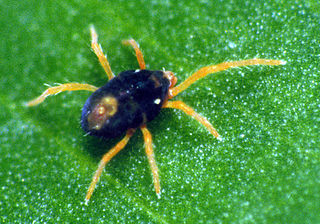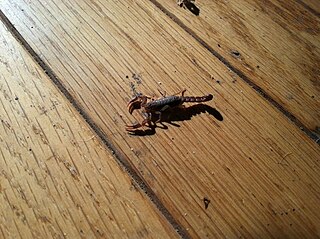Willis John Gertsch was an American arachnologist. He described over 1,000 species of spiders, scorpions, and other arachnids, including the Brown recluse spider and the Tooth cave spider.

Gyalopion canum, commonly known as the Western hooknose snake, is a species of small colubrid snake endemic to the deserts of the United States and Mexico. It is sometimes referred to as the Chihuahuan hook-nosed snake because it is commonly found in the Chihuahuan Desert.

Metepeira labyrinthea, the labyrinth orbweaver, is a spider, with thin legs and a round, bulbous abdomen It is a member of the genus Metepeira in the family Araneidae. The female’s length is 5.3 mm, its carapace 2.3 mm, abdomen 3.3 mm, and extended legs 18.4 mm. The carapace is brown or gray, and the abdomen is dark with a white pattern. The legs alternate pale brown and dark brown, and the sternum is dark brown with a longitudinal yellow mark. The male spider is three-quarters of the female’s length, or slightly larger, with a darker carapace and with greater contrast between dark and light areas of the legs. Metepeira are easily distinguished from other Araneidae by their light eye region, white median line on the sternum, relative length of the leg segments, small male palpus, weakly sclerotized epigyne and the special composite web.

Dolomedes tenebrosus or dark fishing spider is a fishing spider found in the USA and Canada.
Dithella is a genus of pseudoscorpions in the family Tridenchthoniidae. There are at least two described species in Dithella.
Heterolophus is a genus of pseudoscorpions in the family Tridenchthoniidae. There are at least four described species in Heterolophus.
Neoditha is a genus of pseudoscorpions in the family Tridenchthoniidae. There is at least one described species in Neoditha, N. irusanga.
Pycnodithella is a genus of pseudoscorpions in the family Tridenchthoniidae. There are at least two described species in Pycnodithella.
Typhloditha is a genus of pseudoscorpions in the family Tridenchthoniidae. There are at least three described species in Typhloditha.
Verrucaditha is a monotypic genus of pseudoscorpions in the family Tridenchthoniidae. Its sole described species is Verrucaditha spinosa.
Verrucadithella is a genus of pseudoscorpions in the family Tridenchthoniidae. There are at least three described species in Verrucadithella.

Plectreurys castanea is a species of spider. They are found in the United States.
Limnochares americana is a species of mite in the family Limnocharidae.
Limnochares is a genus of mites in the family Limnocharidae. There are at least two described species in Limnochares.
Horribates bantai is a species of windscorpion in the family Eremobatidae.
Horribates is a genus of wind scorpions in the family Eremobatidae. At least three described species are placed in Horribates.

Glycyphagus is a genus of astigs in the family Glycyphagidae. There are about five described species in Glycyphagus.

Glyphanoetus is a genus of astigs in the family Histiostomatidae.

Penthaleus major, known generally as the winter grain mite or blue oat mite, is a species of earth mite in the family Penthaleidae.

Vaejovis carolinianus, the Southern Unstriped Scorpion, also known as the Southern Devil Scorpion, is a species of scorpion in the family Vaejovidae.









